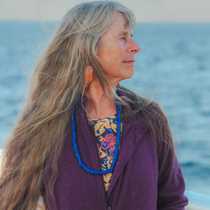Boca de Soledad & Southbound to La Entrada
As the sun rose over the Boca de Soledad, Zodiacs were being loaded for our morning excursions watching Grey whales. The National Geographic Sea Lion had been anchored for two days in the northern end of Bahia Magdalena, one of several Grey whale sanctuaries located on the western side of the Baja peninsula. Our last morning in the Boca was spent watching several cow/calf pairs and many single animals riding in, on the incoming tide. Today would mark a second day of extreme tide conditions due to this evening’s new moon. There was a seven-foot fluctuation in movement of seawater in and out of the Boca de Soledad!
Our Zodiac tours left the fantail at 7:00am, with golden rays of light decorating the surface of the waters around each boat. Blows had been seen in all directions around the NG Sea Lion allowing for very short travel distances, followed by engines being taken out of gear, and we were once again in the company of grey whales and immersed, so to speak, in their world. Baby grey whales, approximately four weeks in age surfaced, took a breath, dove, and continued this process as mothers remained close by. The mothers took one breath to every three or four breaths of their babies. Several cow/calf pairs were practicing spy hops; the mother lifting her head out of the water to eye level then falling into the incoming tidal current. Then, the baby would lift its tiny head up out of the water and also fall into the tidal current or often over the body of its mother. There were several adult animals, also, working the tidal currents all getting in good practice for the northbound journey traveling against the prevailing coastal currents heading north toward their summer home in the Chukchi and Bering seas of northern Alaska.
As the sun climbed into the sky so did our air temperature. A large fog bank had been looming about a mile south of the NG Sea Lion, but did not make enough headway to interfere in the slightest during our whale watching. Many sea birds flew out over the water on their way to the Pacific for a day of fishing. Brown pelicans and Double crested cormorants in full breeding plumage skimmed just inches over the water heading west to the sea searching for a good day’s worth of food. Elegant terns could be heard calling to each other as they also made their respective journeys over the bay, in search of food. All was good and right with the world here in Bahia Magdalena.
As brief visitors to this unique world, each sighting was a gift to behold. All too soon it was time to return to the anchored NG Sea Lion and begin our journey south heading for La Entrada. Our Mexican pilot Alejandro was on board and as soon as all Zodiacs were brought back and stowed we began our departure moving south through Hull Canal. A lovely deck lunch was served, giving even more time for watching our return passage through this narrow channel that separates the smaller nursery lagoon to the north from the larger main body of Bahia Magdalena in the south.
At approximately 4:00pm the NG Sea Lion was positioned with her bow facing directly west into the Pacific Ocean. The rugged southern headland of Isla Magdalena lay directly to the north and to the south an equally rugged headland marked the northern tip of Isla Margarita. These two barrier islands create the wonderfully calm waters we have just spent our first three days exploring. On this night of the new moon the seas were still wonderfully calm and the Pacific greeted us with a gentle roll and wonderfully a cool sea breeze.
The officers of the NG Sea Lion took our vessel straight west and then made a sharp left turn heading south. Immediately our sightings began to change. We saw a cow/calf humpback pair, a masked boobie, and long beaked dolphins bow riding. The bow remained a popular spot for taking in all that could be seen before sunset, even one of our youngest guests, through the artful creativity of his dad enjoyed the views as he made his way around the 200 deck conveniently towed in a milk crate borrowed from the crew!
Calm seas continued past sunset and into the early evening as the National Geographic Sea Lion made her way south along the western side of the Baja peninsula, taking us all into the next half of our adventures exploring this desert by the sea.
To see video footage from today's expedition, click here.




